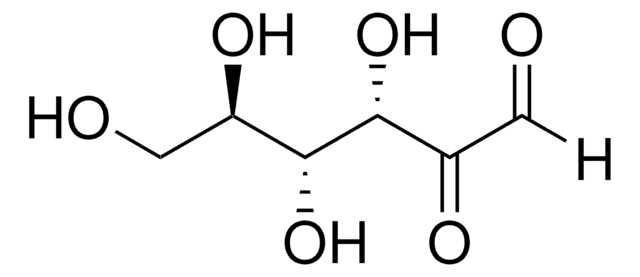75762
3-Deoxyglucosone
≥75% (TLC)
Synonym(s):
3-Deoxy-D-erythro-hexosulose
Sign Into View Organizational & Contract Pricing
All Photos(1)
About This Item
Recommended Products
Quality Level
Assay
≥75% (TLC)
form
solid
color
faintly yellow to orange
storage temp.
room temp
SMILES string
OC[C@H]1OC(O)C(=O)C[C@@H]1O
InChI
1S/C6H10O5/c7-2-5-3(8)1-4(9)6(10)11-5/h3,5-8,10H,1-2H2/t3-,5+,6?/m0/s1
InChI key
UHPMJDGOAZMIID-OPAZFOKUSA-N
Application
3-Deoxyglucosone is used as a reference for the analysis and detection of glucose degradation products, glycating agents, generated by processes such as heat sterilization.
Other Notes
To gain a comprehensive understanding of our extensive range of Monosaccharides for your research, we encourage you to visit our Carbohydrates Category page.
Storage Class Code
11 - Combustible Solids
WGK
WGK 3
Flash Point(F)
Not applicable
Flash Point(C)
Not applicable
Personal Protective Equipment
dust mask type N95 (US), Eyeshields, Gloves
Certificates of Analysis (COA)
Search for Certificates of Analysis (COA) by entering the products Lot/Batch Number. Lot and Batch Numbers can be found on a product’s label following the words ‘Lot’ or ‘Batch’.
Already Own This Product?
Find documentation for the products that you have recently purchased in the Document Library.
Customers Also Viewed
Michael Hellwig et al.
Journal of agricultural and food chemistry, 58(19), 10752-10760 (2010-09-09)
1,2-Dicarbonyl compounds are formed in food during Maillard and caramelization reactions. 3-Deoxy-D-threo-hexos-2-ulose (3-deoxygalactosone, 3-DGal) and galactosone, two 1,2-dicarbonyl compounds originating from the degradation of galactose, were synthesized and converted to the respective quinoxalines, which were characterized by NMR spectroscopy. Analytical
He Li et al.
Journal of agricultural and food chemistry, 67(32), 9050-9059 (2019-07-25)
The control of 2,3-dihydro-3,5-dihydroxy-6-methyl-4(H)-pyran-4-one (DDMP) formation in the Maillard reaction is important to improve the thermally treated food quality as a result of its intense bitterness and potential toxicity. In this work, phenolic acids, such as gallic, protocatechuic, caffeic, and
Danielle T Loughlin et al.
Wound repair and regeneration : official publication of the Wound Healing Society [and] the European Tissue Repair Society, 17(5), 739-749 (2009-09-23)
The interaction of fibroblasts with the extracellular matrix is critical for wound healing. Advanced glycation end products (AGEs) occur through nonenzymatic glycation of long-lived proteins such as collagens. One precursor to these modifications, 3-deoxyglucosone (3DG), is elevated in patients with
Alina Shapira et al.
Molecular nutrition & food research, 51(4), 473-478 (2007-03-29)
Peritoneal dialysis (PD) is commonly performed by using preprepared dialysis solutions containing glucose, which are thermally treated to achieve commercial sterilization. A series of glucose degradation products (GDPs) are being formed, which react with the tissue during the dialysis procedure
Martin Erixon et al.
Peritoneal dialysis international : journal of the International Society for Peritoneal Dialysis, 28(3), 277-282 (2008-05-14)
Glucose degradation products (GDPs) are important in the outcome of peritoneal dialysis (PD) treatment. 3,4-dideoxyglucosone-3-ene (3,4-DGE) is the most cytotoxic GDP found in conventionally manufactured fluids and may, in addition, be recruited from 3-deoxyglucosone (3-DG). It is not known what
Our team of scientists has experience in all areas of research including Life Science, Material Science, Chemical Synthesis, Chromatography, Analytical and many others.
Contact Technical Service





